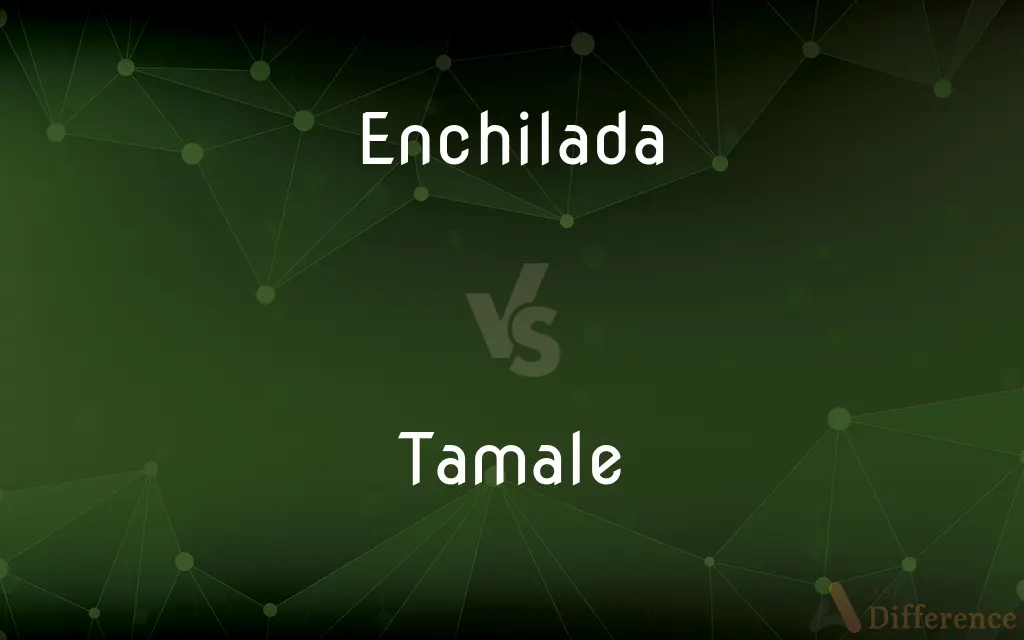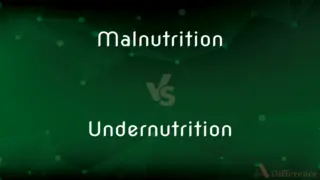Enchilada vs. Tamale — What's the Difference?
By Fiza Rafique & Urooj Arif — Updated on March 12, 2024
Enchiladas are tortillas rolled around a filling and covered in chili sauce, while tamales are corn dough parcels, steamed in corn husks or banana leaves.

Difference Between Enchilada and Tamale
Table of Contents
ADVERTISEMENT
Key Differences
Enchiladas are a traditional Mexican dish made by rolling tortillas around a filling, which can include a variety of ingredients such as meats, cheese, beans, potatoes, vegetables, or combinations thereof. The rolled tortillas are then covered in chili sauce. On the other hand, tamales are made from masa, a dough made from nixtamalized corn (hominy), and can be filled with meats, cheeses, fruits, vegetables, chilies, or any preparation according to taste. Unlike enchiladas, tamales are wrapped in corn husks or banana leaves and then steamed.
While enchiladas are often baked in an oven after being rolled and sauced, tamales are steamed without any additional sauce applied to the exterior. This method of cooking imbues the tamales with a moist texture, whereas enchiladas can have a variety of textures depending on the baking time and ingredients used.
The sauce in enchiladas plays a crucial role, not only adding flavor but also serving as a component that brings the dish together. In contrast, tamales rely on the dough and fillings for flavor, with the corn husk or banana leaf serving as a cooking vessel rather than a flavor component.
Regarding serving, enchiladas are typically served hot from the oven, often with additional toppings such as cheese, sour cream, lettuce, and tomatoes. Tamales, while also served hot, are usually unwrapped from their husks or leaves and can be eaten plain or with sauces and salsas served on the side.
Both dishes hold significant places in Mexican cuisine but are prepared and served in different contexts. Enchiladas are often seen in restaurants and home kitchens as a main dish, while tamales have a strong tradition of being a communal and festive food, often associated with holidays and special occasions.
ADVERTISEMENT
Comparison Chart
Base
Tortilla
Masa (corn dough)
Cooking Method
Baked in sauce
Steamed in corn husks or banana leaves
Texture
Can vary, often soft and saucy
Moist and dense
Serving
Hot, with toppings
Hot, often with sides or sauces
Cultural Significance
Common main dish, widely available
Festive or communal food, holiday associations
Compare with Definitions
Enchilada
A Mexican dish of a corn tortilla rolled around a filling and covered with chili sauce.
She ordered chicken enchiladas at her favorite Mexican restaurant.
Tamale
Steamed to cook, providing a unique texture.
The tamales were steamed for two hours until perfectly cooked.
Enchilada
Traditionally baked in an oven.
The enchiladas were baked until the cheese was perfectly melted.
Tamale
A traditional Mesoamerican dish made of masa steamed in a corn husk or banana leaf.
For the holiday feast, they made pork tamales wrapped in corn husks.
Enchilada
Often served with additional toppings.
The enchiladas were garnished with fresh lettuce, diced tomatoes, and sour cream.
Tamale
Eaten by unwrapping the outer husk or leaf.
They unwrapped the hot tamales and served them with salsa on the side.
Enchilada
Varieties include red, green, and mole sauce-based enchiladas.
They prepared a batch of green enchiladas using homemade tomatillo sauce.
Tamale
Can be filled with meats, cheeses, fruits, vegetables, or chilies.
She enjoyed vegetarian tamales filled with zucchini and cheese.
Enchilada
Enchiladas can be filled with various ingredients, including meats and cheese.
For dinner, they made beef and cheese enchiladas.
Tamale
Associated with festive occasions and holidays.
Making tamales is a family tradition for Christmas in their household.
Enchilada
An enchilada (, Spanish: [entʃiˈlaða]) is a corn tortilla rolled around a filling and covered with a savory sauce. Originally from Mexican cuisine, enchiladas can be filled with various ingredients, including meats, cheese, beans, potatoes, vegetables, or combinations.
Tamale
A tamale or tamal is a traditional Mesoamerican dish, made of masa or dough (starchy, and usually corn-based), which is steamed in a corn husk or banana leaf. The wrapping can either be discarded prior to eating or used as a plate.
Enchilada
A tortilla rolled and stuffed usually with a mixture containing meat or cheese and served with a sauce spiced with chili.
Tamale
A Mexican dish made of chopped meat and crushed peppers, highly seasoned, wrapped in cornhusks spread with masa, and steamed.
Enchilada
A Mexican dish made by wrapping a filling in a tortilla, then baking in a sauce.
Tamale
Mexican dish of cornmeal dough shell filled with various ingredients (e.g. chopped beef, pork, sweet filling) then steamed in corn husks.
Enchilada
Tortilla with meat filling baked in chili-seasoned tomato sauce
Tamale
A Mexican dish made of crushed corn (cornmeal) mixed with minced meat, seasoned with red pepper, dipped in oil, and steamed.
Tamale
Corn and cornmeal dough stuffed with a meat mixture then wrapped in corn husks and steamed
Common Curiosities
How are tamales cooked?
Tamales are steamed in corn husks or banana leaves until the masa is cooked through.
What fillings are commonly used in tamales?
Tamales can be filled with a wide range of ingredients, including pork, chicken, beef, cheese, and vegetables.
Can enchiladas be made with different types of sauce?
Yes, enchiladas can be made with a variety of sauces, including red chili sauce, green tomatillo sauce, and mole.
Can enchiladas be spicy?
Yes, the spiciness of enchiladas depends on the type of chili sauce used.
What is the main ingredient in enchiladas?
The main ingredient in enchiladas is typically a corn tortilla that is filled and rolled.
How do you eat a tamale?
To eat a tamale, you first unwrap it from its corn husk or banana leaf covering.
Are tamales considered a festive food?
Yes, tamales are often associated with festive occasions and holidays, especially in Mexican and Central American cultures.
Are enchiladas served with toppings?
Enchiladas are often served with additional toppings like cheese, sour cream, lettuce, and tomatoes.
What's the difference in texture between an enchilada and a tamale?
Enchiladas can vary in texture but are often softer due to the sauce, while tamales have a moist and dense texture from being steamed.
Do both enchiladas and tamales use corn as a base ingredient?
Enchiladas use corn tortillas, while tamales are made with masa, a dough made from nixtamalized corn.
Is there a vegetarian option for tamales?
Yes, vegetarian tamales can be made with fillings like beans, cheese, and vegetables.
How long does it take to make tamales?
Making tamales can be time-consuming, often requiring several hours for preparation and cooking.
Are enchiladas typically a main dish?
Yes, enchiladas are commonly served as a main dish.
Can you freeze tamales?
Yes, tamales freeze well and can be reheated by steaming or microwaving.
What makes enchiladas different from other tortilla-based dishes?
Enchiladas are unique for being rolled tortillas covered in chili sauce and baked, distinguishing them from dishes like tacos and burritos.
Share Your Discovery

Previous Comparison
Lower vs. Fewer
Next Comparison
Malnutrition vs. UndernutritionAuthor Spotlight
Written by
Fiza RafiqueFiza Rafique is a skilled content writer at AskDifference.com, where she meticulously refines and enhances written pieces. Drawing from her vast editorial expertise, Fiza ensures clarity, accuracy, and precision in every article. Passionate about language, she continually seeks to elevate the quality of content for readers worldwide.
Co-written by
Urooj ArifUrooj is a skilled content writer at Ask Difference, known for her exceptional ability to simplify complex topics into engaging and informative content. With a passion for research and a flair for clear, concise writing, she consistently delivers articles that resonate with our diverse audience.














































